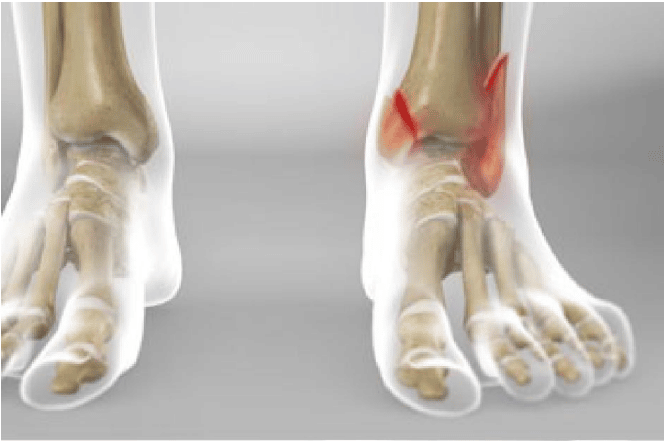Ankle Fracture Surgery
An ankle fracture surgery is a procedure that fixes an unstable break in your ankle. The break can be in either of the bones in the lower leg, the fibula or the tibia, or the break could be in both bones. The broken bone or bones will need to be stabilized by the surgeon so healing can begin.
Symptoms
The Omaha Foot & Ankle Specialists at MD West ONE are able to properly diagnose the condition, an ankle fracture, which may lead to an ankle fracture surgery. If you have the following symptoms, you may want to make an appointment with one of our Board Certified Specialists.
- Tenderness
- Throbbing
- Swelling
- Deformity
- Bruising
- Trouble standing or bearing weight
Types of Ankle Fractures
An ankle fracture can affect different parts of your ankle depending on the type. Types of ankle fractures include:
- Bimalleolar ankle fracture: This fracture happens when you break both bony knobs on your ankle. This is the second most common type of ankle fracture.
- Bimalleolar equivalent fracture: This fracture happens when you break both bony knobs on the outside of your ankle and you damage ligaments inside your ankle.
- Lateral malleolus fractures: This injury can happen when you break the bony knob on the outside of your ankle. This is the most common type of ankle fracture.
- Maisonneuve fracture: This fracture happens when you sprain your ankle and break the upper part of your fibula, near your knee.
- Medial malleolus fractures: This fracture happens when you break the bony knob on the inside of your ankle.
- Pilon fracture: Your tibia ends in a section called the roof of your ankle. When you break this section, it’s called a Pilon fracture.
- Posterior malleolus fracture: There's a bony section on the back of your tibia. This is your posterior malleolus.
- Syndesmotic injury: The syndesmosis joint is located between your fibula and tibia (shinbone) and anchored by ligaments. A syndesmotic injury happens when you have at least one fracture in your tibia or fibula and you sprain ligaments in your syndesmotic joint.
- Trimalleolar fracture: In this case, all three parts of your ankle are broken.
How does an ankle fracture occur?
An ankle fracture is usually a result of a twisting injury, but can also be caused by a direct blow to the ankle.
Some of the most common causes of a broken ankle include:
- Car accidents: Crushing injuries common in car accidents may cause breaks
- Falls: Landing on your feet after jumping down from just a slight height or falling after tripping can cause a break
- Missteps: Putting your foot down wrong can result in a twisting injury that can cause a broken bone
What is the difference between a stress fracture and a bone fracture?
When experiencing symptoms from an ankle injury, it can be hard to tell if you have a stress fracture or a bone fracture. A stress fracture is a tiny crack in your bone. Typically, you have a stress fracture if the pain in your ankle gets worse over time. A bone fracture is when a fracture changes the shape of your bone.

How is a broken ankle treated?
Depending on the level of break, a fractured ankle may not need to be treated with surgery. However, a fractured ankle does need to be treated in some capacity whether it is surgical or non-surgical. If your injury is a stress fracture, you will likely not need surgery. The treatment typically consists of a brace or cast to support the ankle while it heals. Your healthcare provider will be able to create the best treatment plan according to your situation.
Surgical Procedure
If surgery is recommended for your ankle fracture, you will undergo a procedure called an open reduction internal fixation (ORIF). To begin the procedure, you are put under anesthesia, and the surgeon makes a small incision in the skin on both or either side of the ankle, depending on where the injury has occurred. The ankle is inspected and if there are any loose pieces of bone found, they are removed.
After inspection, the joint is then stabilized by using one or more implants which are determined on your needs. These stabilizers can be plates, rods, or screws. The ankle is then closed when the repair is done.
Possible Complications from Ankle Fracture Surgery
Any surgery comes the possible risk of complications. It's important to discuss these with your healthcare provider. For an ankle fracture procedure, these may include:
- Acute compartment syndrome (ACS): This syndrome happens as pressure builds in your muscles and keeps your blood from getting to your muscles and tissues. ACS can cause permanent muscle and nerve damage.
- Bone infection (osteomyelitis): This complication can happen if you have an open fracture which is when your bone breaks through your skin, creating the risk of bacterial infection.
- Malunion: This is when your broken bones don't line up so they can heal correctly.
- Nerve or blood vessel damage: An ankle fracture can damage nerves and blood vessels.
Post Operative Care
After surgery, your ankle is immobilized and you are watched for a brief amount of time while the anesthesia wears off. Most patients can go home the same day and your healthcare provider will give you tips to help you as you heal.
Once the incision is healed, a cast or boot will be fitted on the ankle and it is often recommended to do physical therapy. This regimen typically starts two to four weeks after your ankle fracture surgery occurring two to three times per week. Your doctor will create the post-operative plan right for you, but often times physical therapy can continue for six to eight weeks.
Recovery time depends on how much damage was done when you fractured your ankle. Most people can put weight on their ankle within 16 weeks after surgery, but it can take as long as two years for an ankle fracture to heal completely.
Some key aftercare items to help ensure a full recovery include:
- You'll have to keep your injured ankle elevated for at least two weeks after your surgery.
- You won't be able to put weight on your injured ankle for six weeks after surgery.
- Once you can put weight on your ankle, you’ll be in a cast or walking boot, which could make it difficult for you to get around at work or at school.
- You might be taking medication for pain that could affect your ability to work or go to school.
- You won't be able to drive until your ankle is strong enough to control your vehicle brake and accelerator.
When should you contact your healthcare provider or go to an emergency room?
After surgery if you are experiencing any of the following symptoms, you should contact your healthcare provider or go to the emergency room:
- Uncontrolled pain
- Numbness or tingling
- Increased swelling
- Signs of infection such as fever, chills, redness or your incision is draining
Meet MD West ONE's foot and ankle specialists and learn more about how they treat Achilles tendon injury.
AMERICAN ORTHOPAEDIC FOOT & ANKLE SOCIETY
All of the foot and ankle surgeons in the practice are recognized members of the American Orthopaedic Foot & Ankle Society. It is the oldest and most prestigious medical society dedicated to the foot and ankle. The mission of the society is to advance science and practice of foot and ankle surgery through education, research, and advocacy on behalf of patients and practitioners. These physicians dedicate their time and energy to improving the patient experience and their knowledge in their field. For more information visit http://www.aofas.org.
MD West ONE Foot & Ankle Specialists:
The Foot & Ankle Specialists are all Board Certified and Fellowship-Trained, meaning they’ve focused their education, training and research on orthopaedic surgery of the foot and ankle.





